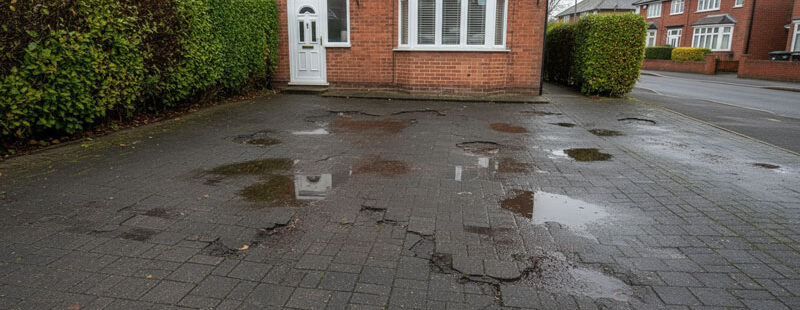
- min min
- No Comments
- November 21, 2025
Why Your Driveway Is Sinking: Causes & Fixes in Hertfordshire
A driveway should stay firm, level, and reliable for many years. So when dips, soft spots, or puddles begin to appear, it’s usually a sign that something is going wrong beneath the surface. Across Hertfordshire, sinking driveways are becoming increasingly common due to ageing installations, changing weather conditions, and growing household vehicle use.
A sinking driveway isn’t just a cosmetic issue. It affects safety, disrupts drainage, and often leads to bigger structural problems if ignored. Understanding why it happens is the first step towards repairing it properly and preventing future damage.
What a Sinking Driveway Really Means
When a driveway begins to sink, the surface isn’t the real problem — the ground underneath is. The top layer may be resin, tarmac, block paving, or concrete, but all driveway materials rely on a strong, stable sub-base. Once the base weakens, shifts, or collapses, the surface begins to dip, creating low spots, cracked areas, or sections that collect water.
Homeowners typically notice a sinking driveway when tyre tracks form depressions, when puddles remain after rain, or when the driveway appears uneven where it meets the road or garage entrance. These early signs indicate that the support beneath the surface is failing.
Poor Sub-Base Construction: The Root of Most Problems
The most common reason for a sinking driveway in Hertfordshire is a poorly constructed sub-base. Many older properties — especially those built on fast-developing estates — had driveways installed quickly with minimal groundwork. Some were laid directly over soil or thin layers of mixed rubble rather than proper MOT Type 1 stone.
Without a strong foundation, the weight of vehicles slowly compresses the ground underneath. Over time, the driveway begins to sag in the areas with the weakest support. The surface material isn’t to blame; it’s the structure beneath that has failed.
Insufficient Compaction Leads to Gradual Sinking
Even when the correct sub-base material is used, it must be compacted properly. If it isn’t pressed firmly in layers using professional machinery, it can loosen and settle months or years later. Many Hertfordshire homeowners inherit driveways that were compacted too quickly, compacted in poor weather, or laid in thick layers rather than thin, controlled passes. This hidden weakness only becomes visible long after installation.
Drainage Issues and Water Damage
Heavy rainfall is common across Hertfordshire, and water can be one of the biggest threats to a driveway. When the water does not drain correctly, it seeps downwards and erodes the base. Soil softens, small gaps form, and eventually the driveway begins to drop into these weakened areas.
Blocked gullies, failing soakaways, incorrect gradient levels, and water flowing from surrounding gardens are all contributors. Driveways with standing water or areas that take too long to dry after rain almost always have a drainage issue developing beneath them.
Tree Roots and Soil Movement in Hertfordshire
Hertfordshire has many mature, established neighbourhoods with large trees lining the streets or growing in front gardens. Tree roots naturally spread outwards in search of moisture and often reach beneath driveways. As roots grow, they can lift some areas while causing small voids around others, leading to uneven sinking.
Clay soil is also common in parts of Hertfordshire. This type of soil expands during wet conditions and contracts during dry spells, causing subtle but frequent ground movement. Over time, this natural shifting can destabilise the driveway base.
Pressure from Heavy Vehicles
Driveways are often designed with standard family car use in mind. When heavier vehicles begin using the same driveway — delivery vans, work trucks, or even large SUVs — the extra weight places stress on areas that weren’t built to handle it. Repeated pressure in the same spots gradually compresses the base, causing dips and soft patches.
Block Paving Failures and Shifting Edges
Block paving driveways can sink for slightly different reasons. If the bedding sand beneath the blocks becomes saturated or washes away, the blocks lose support and begin to drop. Edge restraints that move or fail can also cause the driveway to spread outward, creating dips in the middle. Without strong edging and proper jointing, block paving becomes more vulnerable to sinking over time.
How to Fix a Sinking Driveway the Right Way
The best repair method depends on the extent of the sinking, but lasting solutions always begin with addressing the base. Shallow dips in block paving may be repaired by lifting the blocks, re-levelling the bedding layer, and reinstalling them. However, deeper or widespread sinking usually requires excavation of the failed area and rebuilding the sub-base correctly with well-compacted MOT Type 1.
When drainage is the cause, additional work may include installing new channel drains, creating a better fall to direct water, or repairing existing drainage points. For areas affected by tree roots, root trimming or the installation of root barriers may be necessary before rebuilding the driveway. In every case, the key is restoring the foundation, not just resurfacing the top layer.
Preventing Future Sinking
Once repaired, a driveway can remain stable for decades if built properly. A strong sub-base, appropriate drainage, reliable edging, and correct compaction are the foundations of a long-lasting surface. Avoiding excessive weight on sensitive areas, keeping drainage channels clear, and addressing small issues early will also help maintain the driveway’s stability.
Final Thoughts for Hertfordshire Homeowners
A sinking driveway may feel like a frustrating problem, but it’s usually straightforward to diagnose and correct. The sinking simply indicates that the support beneath the driveway has failed, and once that foundation is rebuilt properly, the problem rarely returns.
For anyone dealing with a sinking driveway Hertfordshire, a professional repair gives you a smooth, safe, long-lasting surface and restores your home’s kerb appeal. A well-constructed driveway is an investment, and when the underlying structure is done right, it will stay solid for many years to come.





